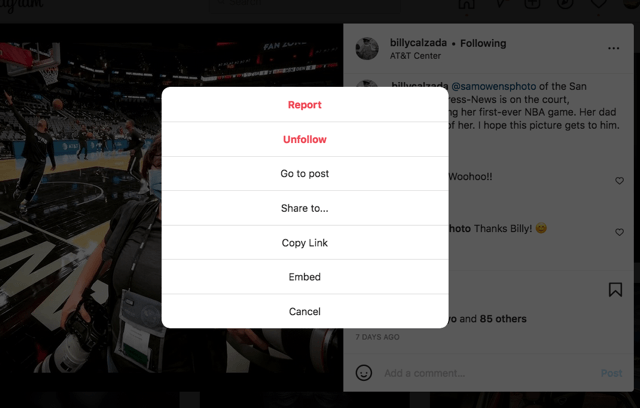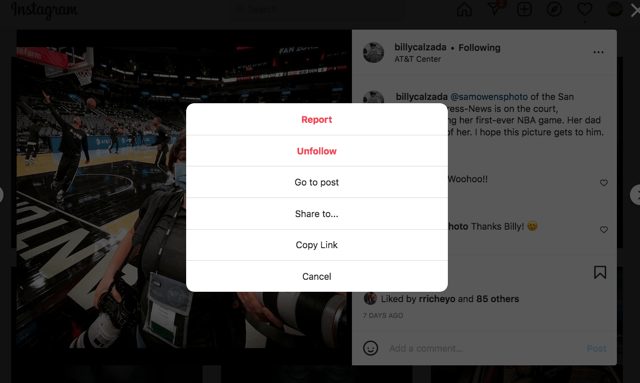How Instagram Changed Its Embedding Feature—and What That Means for Photographers and Publishers

In mid-December of 2021, Instagram quietly let it be known that it had added a feature to its service that allows users to disable its commonly misused and misunderstood embedding feature. The news spread like wildfire throughout the photographic community, which was thrilled that a feature long requested by photographers and their trade associations, including the National Press Photographers Association (NPPA) and the American Society of Media Photographers (ASMP), had been implemented. The new feature is now available to users, though at this time you cannot pick and choose which posts can be embedded.
When a user posts an image on Instagram, there is a technical mechanism that allows a viewer to click on the image and embed it into a blog post, social media post, or online article. The operative word, though, is “technical.” While the technology allows the embedding to happen, embedding a visual work without permission is still a potential copyright violation. The Copyright Act protects not just unauthorized copying of visual works, but also unauthorized public “display” of a work. Previously, photographers who didn’t want their Instagram posts to be embedded without permission had one option in order to prevent it—they could make their account “private” and require people to specifically ask to follow them in order to view their Instagram feed. This prevented unauthorized embedding, but it also prevented potential clients from viewing a photographer’s Instagram without taking that extra step, something that could make the difference between who got an assignment and who didn’t. With the late 2021 change to Instagram’s service, U.S. photographers can now keep their account “public” and use a checkbox or toggle a switch that prevents embedding. The feature was rolled out to U.S. users first, and Instagram has said that they will be rolling it out internationally this year.


What steps should photographers and other visual artists take when posting photos on Instagram?
If you are in the business of licensing images, you may want to strongly consider blocking embedding as a way to prevent infringement. Even if you don’t license images professionally, you own your copyright and it’s worth protecting. Blocking embedding is now easy—there are instructions in the Instagram help section, and there are also several articles outlining the process, including this guide on Petapixel.

When the feature first rolled out, some photographers and users in general had trouble implementing it for technical reasons or lack of availability. If you are struggling to figure it out after following the instructions, it might be because: 1) you’re using the mobile app and haven’t updated your app; 2) you’re not in the U.S. and it’s not available in your country yet (we’ve been told that it’s rolling out globally in 2022); or 3) your account is private, so it already blocks embedding.
Importantly, if you do nothing, embedding is the default setting and will remain enabled. So, it’s really worth your time to take the steps above.
What Image users need to know about the embed-disabling feature.
The advice I always give is simple—ask permission before you use an image. That hasn’t changed. Unless you have been advised by a lawyer that fair use truly applies, you should continue to avoid embedding without permission.
Photographers have filed multiple lawsuits against publishers for embedding social media posts of images (see, e.g., Sinclar v. Ziff Davis, McGucken v. Newsweek). When faced with claims of copyright infringement based on Instagram (or Twitter) embedding, publishers who embedded Instagram works have relied on multiple principles to defend their actions. But each of them is risky.
The first was the “server test,” established in the Ninth Circuit in the case of Perfect 10 v. Amazon.com, LLC , which posits that an image user who embeds does not infringe a copyright because the copy of the work does not reside on that image user’s servers. However, federal courts in Texas and New York have rejected the server test as a defense to embed-based infringement, noting that it is a court-created doctrine that goes against the plain reading of the Copyright Act, which grants a copyright holder the right to control the display of a copyrighted work. The judge in Goldman v. Breitbart News Network, LLC applied this reasoning to an embed of a photograph originally posted on Twitter and found that an embedded tweet of a photograph violated the display right. Courts in the Ninth Circuit generally continue to follow the server test—and one California court, in Hunley v. Instagram, practically invited an appellate review of the principle, stating that while other courts can ignore Perfect 10, it was bound by the precedent and it’s up the Ninth Circuit court of appeals to revise it.
A second argument arose and failed in multiple Instagram embedding cases. In some cases, lawyers claimed that Instagram—whose terms of service grant them permission to sublicense images posted on their service–had actually sublicensed these images to publishers who embed. However, while Instagram’s terms certainly provide Instagram a broad license that includes the right to sublicense, a detailed reading of the user agreement doesn’t specifically grant any sublicensing rights to anyone for use outside of the platform. In fact, the terms expressly require API users to obtain permission for embeds that they use. In Sinclair v. Ziff Davis, the district court judge determined (at the motion to dismiss stage) that there was no evidence that there was ever a sublicense issued to the defendant. Around that same time, Instagram came out publicly and stated that “Instagram does not provide users of its embedding API a copyright license to display embedded images on other websites”, and its platform policies require API users to obtain a license to any content on Instagram that they share.
Given that Instagram users can now choose to disable embedding, publishers might be again wondering whether it might be okay to embed without asking. Since a user can choose to block embedding, does leaving the ability to embed equate to an implied license to embed? Not likely. When Instagram added the feature to allow embed disabling, it left the embed functionality as the default. So, unless an IG user actively goes in and disables embedding, the ability to embed remains.
There may be any number of reasons why a user hasn’t disabled embedding. First, it’s not available to all users. For example, the user might be outside of the U.S. and awaiting the feature to roll out in another country. Second, the photographer might not know that the feature exists. Third, someone might want to allow embedding for some people but not others. And finally, it’s possible that the Instagram account user uploaded a photo that either isn’t theirs or that they don’t have the rights to license, making any kind of implied license irrelevant. It simply cannot be assumed that an Instagram post equals an explicit choice to share an image beyond the platform.
While this technical change sent a wave across the photo community, the best practices for publishers should remain the same. If you want to use an image, ask for permission and license it.
If you aren’t already a member of the Copyright Alliance, you can join today by completing our Individual Creator Members membership form! Members gain access to monthly newsletters, educational webinars, and so much more — all for free!

